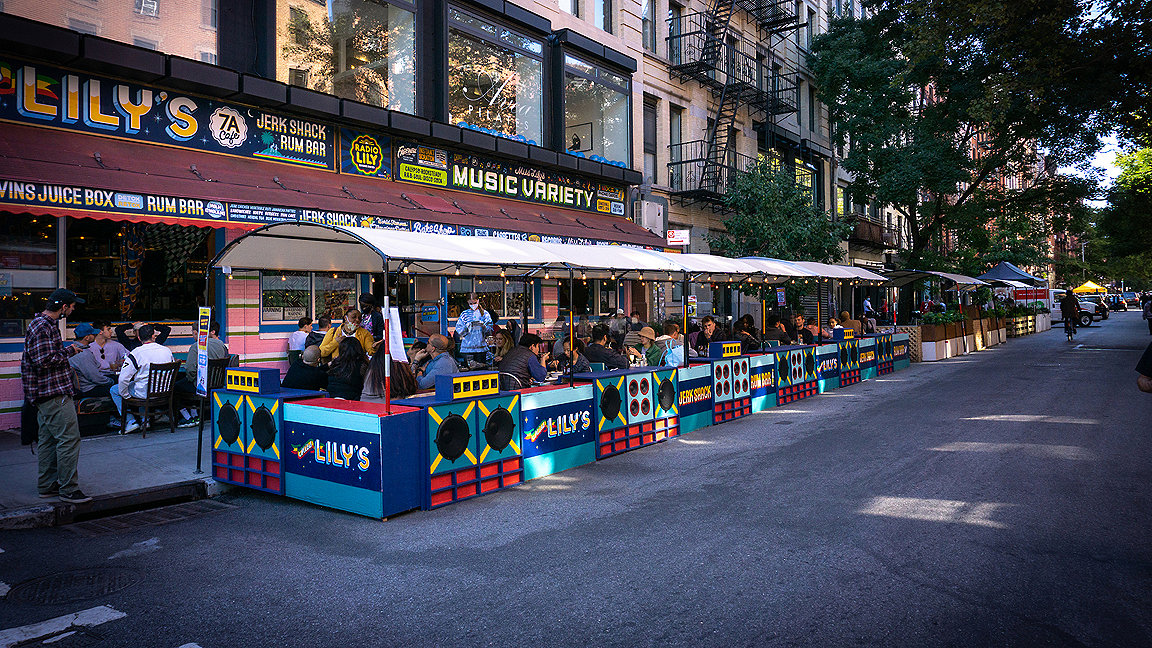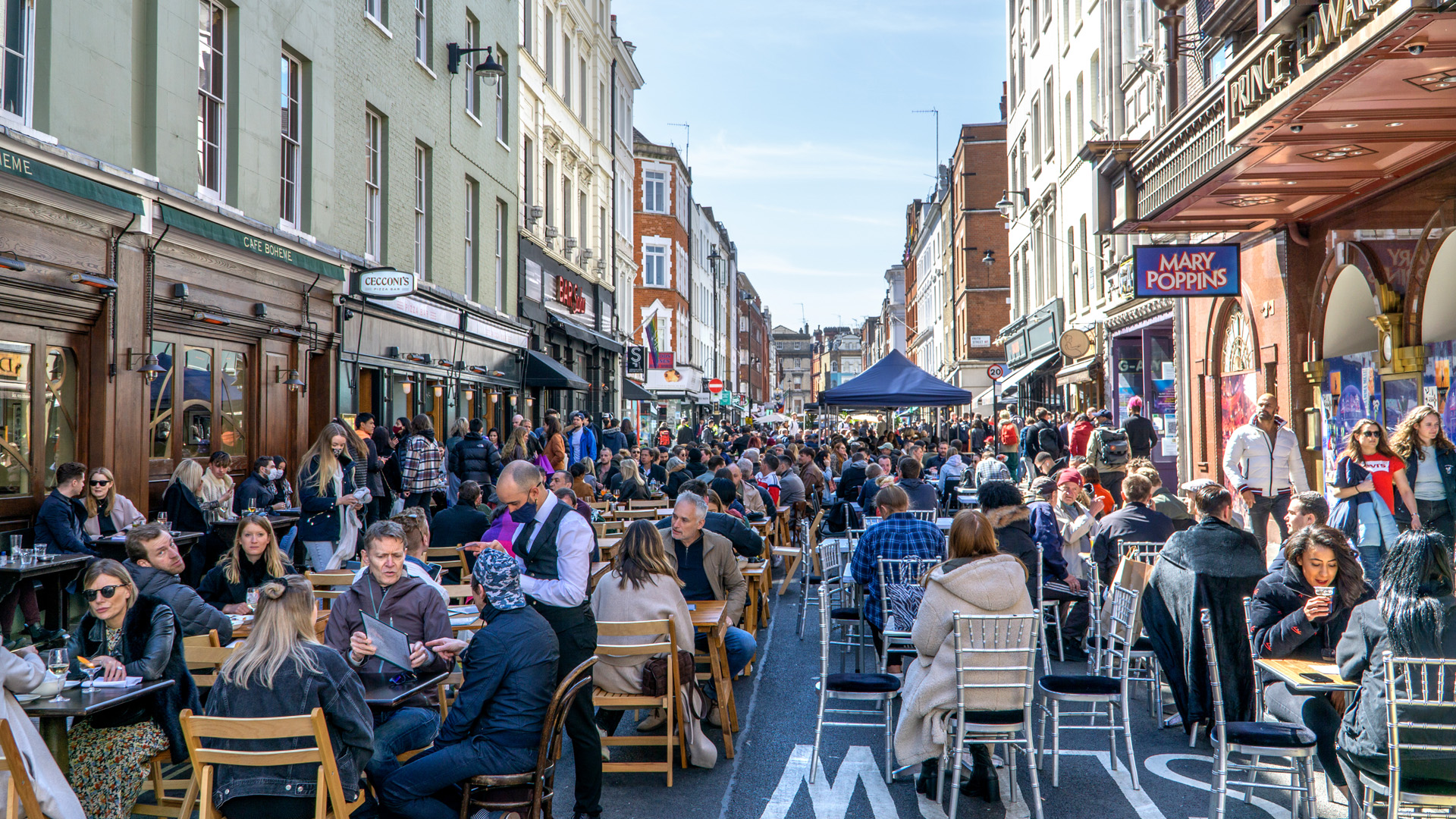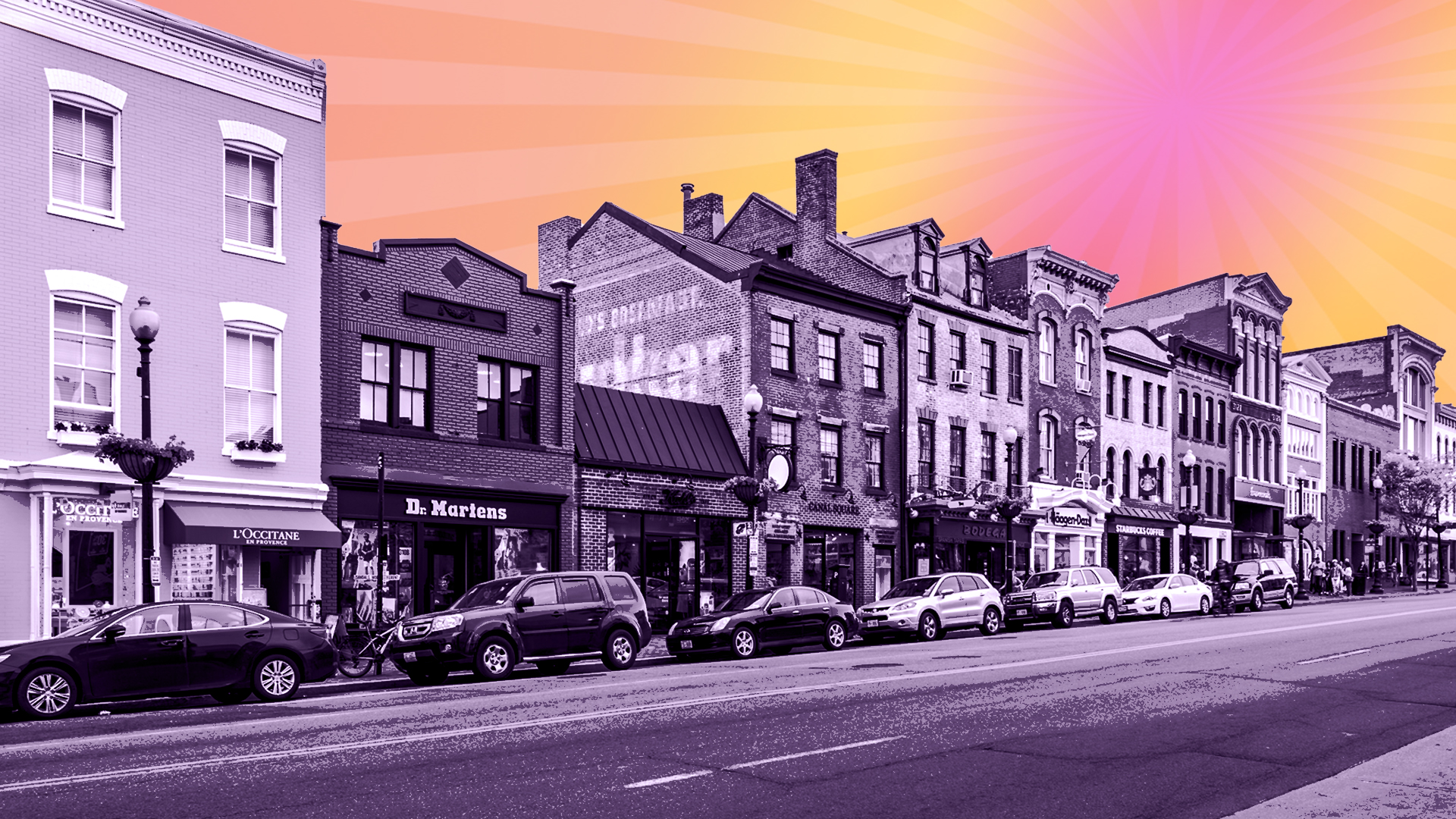
In spring 2020, Ryan Smolar was in despair. Foot traffic had evaporated seemingly overnight in the blocks he manages that are part of the business improvement district (BID) Downtown Santa Ana, serving the small city of Santa Ana near Los Angeles. Parking revenues were down 75%, costing his organisation half its annual revenue. The municipal government had cancelled the district’s contract to provide “clean and safe” services like graffiti removal and additional rubbish pick-up.
Once the backer of events that brought throngs of visitors to the palm tree-lined city centre ringed by heritage buildings, he had turned into a glorified takeout promoter in a desperate bid to keep restaurants afloat.
Glancing at his phone one morning and bracing for more depressing news, a headline jumped out: Cities in Northern California were allowing restaurants to spill over into the street. Smolar immediately began lobbying Santa Ana city officials to allow the same.
“After seven years of asking for parklets (miniature parks on roads or pavements), the city agreed,” he says. “We pulled up a map of downtown and started drawing them in, one after another.”
Downtown Santa Ana invested $8,000 in barricades to fence off 24 outdoor dining terraces that occupied former on-street parking spaces. After a successful first year that saw visitors return to downtown even amid the COVID-19 pandemic, city officials invested $4.5m in federal COVID-19 relief funds to build permanent parklets that met city code.
“All the over-scrutinising and permit issuing that limits so much entrepreneurship in our district was lifted,” says Smolar. “And no bureaucrat was harmed in the process.”
The effort by Smolar and his team at Downtown Santa Ana is one example of how BIDs and business improvement associations (BIAs) stepped up to keep city-centres and high streets vibrant in their darkest hour.
These quasi-public organisations, which levy businesses in a defined geographic area to pay for specific services like beautification and marketing, are sanctioned by government but operate independently. A group of Toronto merchants invented the concept in 1970 when they established the Bloor West Village BIA to brighten their local main street and retain customers against the onslaught of suburban shopping malls. Over 50 years later, the concept has spread: Downtown BIDs exist in every major North American city, with more than 80 in Toronto and New York City, as well as a sprinkling in South Africa, Germany, Japan, and Serbia. The UK’s Local Government Act of 2003 allowed England and Wales to establish BIDs, while Scotland approved the concept in 2007.
Typically both business and property owners pay into a BID on a proportional basis, though specifics vary widely in the US and Canada, where individual municipalities set the rules through enabling legislation. The UK is more uniform with a regularly scheduled balloting process to approve or reauthorize a BID.
BIDs can face an uphill battle, given the general aversion to higher taxes. “The first reaction to creating a BID in any city is ‘Are you crazy? I already pay too many taxes to a government that I don’t like and now you want me to pay more’,” says Paul Levy, executive director of the Center City District in Philadelphia. As one of the longest serving BID heads in the US with over 30 years of experience, he has advised early gestation BIDs around the world and teaches on the subject at the University of Pennsylvania.
But, he argues, the struggles facing CBDs (central business districts) and high streets over the past 18 months has proven the worth of BIDs. “We supplement – we don’t replace – city services,” he says. “But if people are frustrated with the lack of resources a government has, they look to us. We were out there and visible. BIDs in most cities were a positive, reassuring presence.”
In Philadelphia’s case, the Center City District began cleaning graffiti from street signs, emptying public trash cans, and sending out unarmed bike patrol officers during a period when city services shrank, whether due to budget cuts or political decisions by elected officials. Even though these enhanced efforts meant crossing the line into performing services typically the responsibility of local government, Levy says his board of directors backed the move unanimously. “We are in a fight for our lives in cities because of the pandemic,” he says. “This is our role and mission.”
The end result has been the Center City District collecting over 90% of its annual revenue in 2020 and 2021, despite fears of a cataclysmic drop. The same stalwart support from businesses kept FOR Cardiff afloat. “We were pleasantly surprised by how high the collection rate was,” says Emily Cotterill, project manager for the BID covering the Welsh capital’s CBD. “It demonstrated that businesses saw the value in the BID because they were still choosing to pay in a difficult period. It was an investment worth making.”
Those British BIDs that have gone through a reauthorisation process in the pandemic era have mostly fared well, with Sheffield, Nottingham, Bath, and several central London BIDs all winning their ballots. Only the BID serving the town centre of Basingstoke, which has fewer than 100,000 residents, failed to win reauthorisation.
“All the over-scrutinising and permit issuing that limits so much entrepreneurship in our district was lifted. And no bureaucrat was harmed in the process.” Ryan Smolar, Downtown Inc, Santa Ana

The levy that businesses and property owners situated in BIDs are expected to pay is worked out in different ways, depending on the country. In North America, BIDs tend to be tied to real estate values and the pace of economic recovery may eclipse low valuations. In the UK, ratepayers calculate their levies based on rateable values determined nationwide in 2017. Rateable value is not set to be recalculated until 2023, by which time CBDs and commercial districts may have rebounded to pre-pandemic levels.
Ultimately, BIDs serving CBDs have been in the most precarious situation as they seek to convince workers and visitors alike to return to downtown settings. For neighbourhood shops and businesses, especially in more affluent quarters where residents are liable to work from home and shop locally during the week, BIDs were helpful but not always essential for economic recovery.
“The city injected CAD$25m (£14.6m) into events and neighbourhoods where BIAs are active,” says Alexandra Faciu MRICS, a Montréal-based executive experienced in asset management, investment, and transformation. “But some high streets took off without intervention from BIAs, depending on the demographic profile.”
Still, neighbourhood main street BIDs play a valuable role, especially in larger cities. Rachel Witt is the executive director of the South Grand Community Improvement District in St Louis, a Midwestern US city. “Having an ambassador for a business district to the community and a liaison to the municipality is instrumental,” she says. As one small example, she arranges for annual tree trimming along her the main street, which the municipal forestry department admits they would accomplish only once every five years. And in a moment of acute crisis, the BID binds businesses together. In 2014, police brutality protests in St Louis turned violent, leading to broken windows on 15 businesses along the corridor, plus an attempted arson of a bank branch.
“By the time I arrived at 6am, residents had come out and cleaned up every piece of glass, brought plywood and duct tape to secure windows, and stood there until the business owners arrived,” she says. “They were scared. I put together a meeting with the property owners, the businesses, and the community to organise mural painting on the plywood. Through the City of St Louis and a GoFundMe campaign that we started, everyone was reimbursed 100% for damaged windows and boarding up costs.”
Such scenes were repeated in 2020 when some racial justice protests led to widespread property damage in US cities. Once again, BIDs stepped in to clean up and restore their commercial corridors.
“In a moment of crisis, somebody has to lead,” says Levy.
Make sure you don’t miss anything on Modus by signing up for our newsletter.
“The first reaction to creating a BID in any city is ‘Are you crazy? I already pay too many taxes to a government that I don’t like!’” Paul Levy, Center City District, Philadelphia

